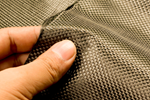Bally Ribbon Mills presents Kevlar webbing, tapes for military applications
High-performance Kevlar solutions deliver the strength, durability and protection required to meet demanding environments, defense specifications.
Source | Bally Ribbon Mills (BRM)
(BRM, Bally, Pa., U.S.), a company that designs, develops and manufactures specialized engineered woven fabrics, highlights its high-performance Kevlar webbing and tapes, specifically designed to meet the stringent Mil-T-87130 military specification. Kevlar, a para-aramid synthetic fiber, is often used in combination with other materials like carbon and glass fiber.
BRM’s is recognized for its high tensile strength and toughness. Constructed from heat-resistant synthetic fibers, this webbing provides protection against cuts, tears and punctures, ensuring dependable performance even in extreme conditions. The durability of Kevlar translates to enhanced safety for military personnel and equipment.
In addition to its strength, the company’s Kevlar webbing remains lightweight and flexible. This combination facilitates easy handling and integration into diverse applications, reducing the overall weight of gear while improving mobility for military personnel. The flexibility of the webbing makes it suitable for a wide range of products, including parachute reinforcement, load-bearing equipment and personal protective gear.
A key feature is the material’s high resistance to heat and flame. This property adds an essential layer of protection in environments where exposure to high temperatures is a concern. The inherent flame resistance of Kevlar ensures that the webbing will not burn, melt or drip, making it a critical component for firefighting gear and fall protection harnesses.
All of BRM’s Kevlar webbing products are manufactured to meet or exceed military specifications, ensuring reliable performance in critical applications.
Related Content
-
Call for abstracts: CW Tech Days to explore high-temperature composite solutions
The fall 2025 installment of CW’s Tech Days online event series will cover high-temperature composite solutions for defense and space applications.
-
The AAMMC Tech Hub: Ramping U.S. production of large thermoplastic composite aerostructures
CW talks with Syensqo, Spirit AeroSystems and other consortia members about current funding, specification of the next world’s largest press, organizational structure and projects to support U.S. companies in the race to deliver >40,000 sustainable and efficient aircraft over the next 20 years.
-
Orbital Composites wins AFWERX award for Starfighter drone fleet
Under the TACFI contract, Orbital is implementing the AMCM process to build 3D printed composite multi-mission UAS aircraft, surpassing $10 million in government awards.






